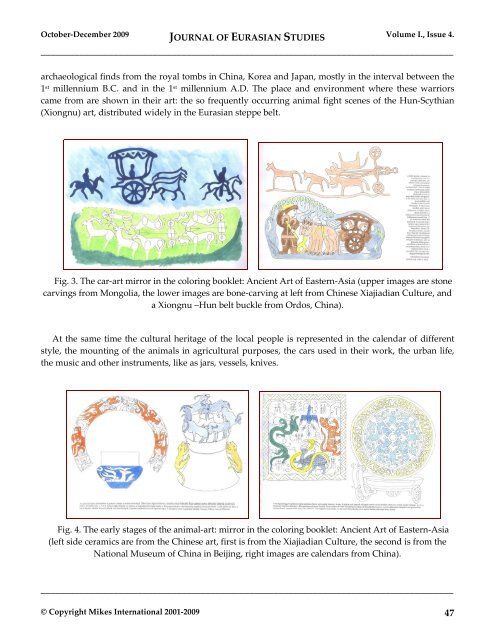JOURNAL OF EURASIAN STUDIES
JOURNAL OF EURASIAN STUDIES
JOURNAL OF EURASIAN STUDIES
Create successful ePaper yourself
Turn your PDF publications into a flip-book with our unique Google optimized e-Paper software.
October-December 2009 <strong>JOURNAL</strong> <strong>OF</strong> <strong>EURASIAN</strong> <strong>STUDIES</strong> Volume I., Issue 4.<br />
_____________________________________________________________________________________<br />
archaeological finds from the royal tombs in China, Korea and Japan, mostly in the interval between the<br />
1 st millennium B.C. and in the 1 st millennium A.D. The place and environment where these warriors<br />
came from are shown in their art: the so frequently occurring animal fight scenes of the Hun-Scythian<br />
(Xiongnu) art, distributed widely in the Eurasian steppe belt.<br />
Fig. 3. The car-art mirror in the coloring booklet: Ancient Art of Eastern-Asia (upper images are stone<br />
carvings from Mongolia, the lower images are bone-carving at left from Chinese Xiajiadian Culture, and<br />
a Xiongnu –Hun belt buckle from Ordos, China).<br />
At the same time the cultural heritage of the local people is represented in the calendar of different<br />
style, the mounting of the animals in agricultural purposes, the cars used in their work, the urban life,<br />
the music and other instruments, like as jars, vessels, knives.<br />
Fig. 4. The early stages of the animal-art: mirror in the coloring booklet: Ancient Art of Eastern-Asia<br />
(left side ceramics are from the Chinese art, first is from the Xiajiadian Culture, the second is from the<br />
National Museum of China in Beijing, right images are calendars from China).<br />
_____________________________________________________________________________________<br />
© Copyright Mikes International 2001-2009 47
















